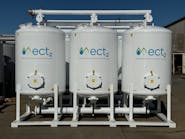This article has been updated on Dec. 18, 2023 at 2:49 p.m. to include quotes from the American Water Works Association (AWWA).
The U.S. EPA released its annual Per- and Polyfluoroalkyl Substances (PFAS) Progress report Dec. 14, highlighting some key achievements, but the drinking water and wastewater industry worries it is too little too late.
Among the achievements listed in the U.S. EPA press release are $1 billiion in infrastructure funding in 2023 for PFAS projects; new PFAS reporting requirements for the Toxic Release Inventory; and changes to the pretreatment and monitoring programs for National Pollutant Discharge Elimination System requirements. The agency also noted its proposal to add PFAS chemicals to the Comprehensive Environmental Response, Compensation and Liability Act, commonly known as CERCLA or the Superfund, as an achievement, as well.
U.S. EPA Assistant Administrator to the Office of Water Radhika Fox said EPA established its Council on PFAS, which has been charged with carrying out the PFAS Strategic Roadmap. The council includes department leaders from across the entirety of EPA to ensure it is taking a holistic approach to addressing PFAS with a focus on data and science.
“So we’ve been investing in the science,” Fox said, “then we’ve got to restrict PFAS. We’ve got to turn the tap off on PFAS, so we’re using a range of statutory authority to again turn the tap off on PFAS. And then we’ve got to remediate.”
Maximum Contaminant Levels Proposal
In March 2023, EPA released its Maximum Contaminant Level (MCL) Proposal for the National Primary Drinking Water Regulations for six PFAS. The two most prominent chemicals — perfluorooctane sulfonic acid (PFOS) and perfluorooctanoic acid (PFOA) — had 4 parts per trillion (ppt) in the MCL proposal. The remaining four chemicals were proposed to be regulated by summing their concentrations in water using a formula referred to as the PFAS Hazard Index.
Water and wastewater professionals and industry leaders pushed back on this proposal in public comments, and noted the challenge to meet them is too great with too few resources, particularly funding. Fox said that the Infrastructure Investment and Jobs Act, which EPA calls the Bipartisan Infrastructure Law, set aside $15 billion in funding for water agencies to address PFAS chemicals in water, adding $1 billiion in funding had been issued in 2023 for this purpose.
Mike McGill, president of WaterPIO, is a communications consultant for municipal water and wastewater systems. He said the EPA PFAS Progress Report points to a larger issue he sees brewing in the industry.
“If EPA lowers the PFAS MCLs to 4 and 4 ppt, and the nation's water providers have to meet that in three to five years, guess where all the money, staff and other resources are going to be put toward: PFAS,” McGill said, noting drinking water systems are also tasked with meeting new requirement of the Lead & Copper Rule limiting lead to 10 ppb. “If a water provider's corrosion control is working well, keeping the sampling well under 10, they will put off the lead work, rolling the dice on future position, because they could get non-stop [Notices of Violation] NOVs for their drinking water in just three years.”
Fox said EPA expects to release the final rule for the PFAS Maximum Contaminant Levels after the New Year.
“We are very appreciative of really the whole ecosystem of water stakeholders that provided such important feedback on that drinking water proposal,” Fox said. “We really worked hard to analyze that feedback and we are currently at the interagency review with the drinking water MCL, and we are looking to have a final rule in early 2024.”
Unregulated Contaminant Monitoring Rule 5
McGill said there are known areas of PFAS drinking water contamination throughout the U.S., a fact that is validated through the Unregulated Contaminant Monitoring Rule 5 (UCMR5), which monitors for 29 PFAS compounds and lithium.
Fox said that, while the UCMR5 data is preliminary with only two rounds of data so far, what has been monitored and tracked lines up with data from other studies. That data, she said, will arm the agency and industry professionals in addressing PFAS chemicals in water.
“It's going to be a real game changer of the having all of that UCMR data. It's really going to support our local water agencies to understand what's happening, what they're drinking water source is, and to plan,” Fox said.
She reiterated that the Bipartisan Infrastructure Law funding is a historic resource for utilities, and encouraged water systems across the country to apply for state revolving funds to access that federal funding signed into law in November of 2021.
McGill said the UCMR5 data sheds light on just how widespread the contamination of PFAS is in the United States. Looking at the bigger picture, he pointed to the scale of manufacturing solutions and equipment to treat the chemicals as a headwind.
“Based on the first couple of rounds of UCMR 5, we’re looking at thousands of water providers needing advanced treatment to be added to their systems, and all within the next three to five years,” McGill said. “That’s untenable. There won’t be enough systems or media to go around, and the systems that are available will jump in cost to the providers and — because we’re not punishing the polluters enough — the customers.”
Fox said future data of the UCMR5 will be available on the U.S. EPA website, where quarterly updates will published for the public.
The American Water Works Association (AWWA) also shared its thoughts on the report.
"The report report detailed several important efforts by the agency that will have wide-ranging impacts on communities and the broader public health," said Chris Moody, regulatory technical manager for AWWA. "Many of these actions have been called for by and supported by AWWA over the years."
However, shared Moody, the accountability of polluters and affordability of regulations are still concerns for AWWA.
"While the report highlights the many steps to address PFAS the agency has taken, it does not include significant steps to limit ongoing PFAS uses and releases and to hold polluters accountable," Moody said. "As the new year approaches, EPA is set to finalize drinking water standards and hazardous substances designations for PFAS, both of which are expected to require a significant investment from communities that will far exceed federal funding available."




